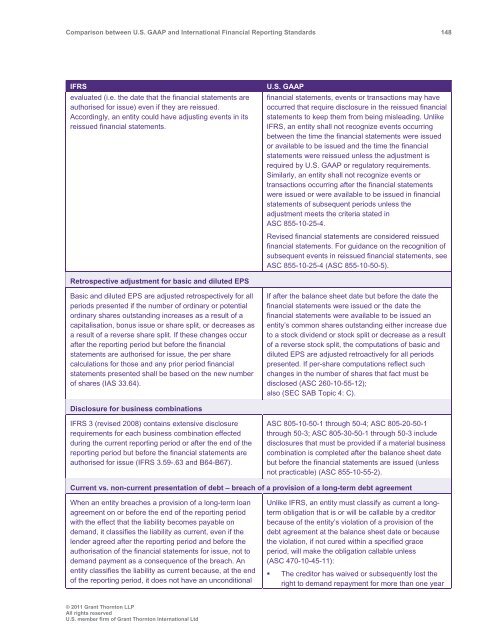Comparison between U.S. GAAP and International ... - Grant Thornton
Comparison between U.S. GAAP and International ... - Grant Thornton
Comparison between U.S. GAAP and International ... - Grant Thornton
You also want an ePaper? Increase the reach of your titles
YUMPU automatically turns print PDFs into web optimized ePapers that Google loves.
<strong>Comparison</strong> <strong>between</strong> U.S. <strong>GAAP</strong> <strong>and</strong> <strong>International</strong> Financial Reporting St<strong>and</strong>ards 148<br />
IFRS<br />
evaluated (i.e. the date that the financial statements are<br />
authorised for issue) even if they are reissued.<br />
Accordingly, an entity could have adjusting events in its<br />
reissued financial statements.<br />
U.S. <strong>GAAP</strong><br />
financial statements, events or transactions may have<br />
occurred that require disclosure in the reissued financial<br />
statements to keep them from being misleading. Unlike<br />
IFRS, an entity shall not recognize events occurring<br />
<strong>between</strong> the time the financial statements were issued<br />
or available to be issued <strong>and</strong> the time the financial<br />
statements were reissued unless the adjustment is<br />
required by U.S. <strong>GAAP</strong> or regulatory requirements.<br />
Similarly, an entity shall not recognize events or<br />
transactions occurring after the financial statements<br />
were issued or were available to be issued in financial<br />
statements of subsequent periods unless the<br />
adjustment meets the criteria stated in<br />
ASC 855-10-25-4.<br />
Revised financial statements are considered reissued<br />
financial statements. For guidance on the recognition of<br />
subsequent events in reissued financial statements, see<br />
ASC 855-10-25-4 (ASC 855-10-50-5).<br />
Retrospective adjustment for basic <strong>and</strong> diluted EPS<br />
Basic <strong>and</strong> diluted EPS are adjusted retrospectively for all<br />
periods presented if the number of ordinary or potential<br />
ordinary shares outst<strong>and</strong>ing increases as a result of a<br />
capitalisation, bonus issue or share split, or decreases as<br />
a result of a reverse share split. If these changes occur<br />
after the reporting period but before the financial<br />
statements are authorised for issue, the per share<br />
calculations for those <strong>and</strong> any prior period financial<br />
statements presented shall be based on the new number<br />
of shares (IAS 33.64).<br />
If after the balance sheet date but before the date the<br />
financial statements were issued or the date the<br />
financial statements were available to be issued an<br />
entity’s common shares outst<strong>and</strong>ing either increase due<br />
to a stock dividend or stock split or decrease as a result<br />
of a reverse stock split, the computations of basic <strong>and</strong><br />
diluted EPS are adjusted retroactively for all periods<br />
presented. If per-share computations reflect such<br />
changes in the number of shares that fact must be<br />
disclosed (ASC 260-10-55-12);<br />
also (SEC SAB Topic 4: C).<br />
Disclosure for business combinations<br />
IFRS 3 (revised 2008) contains extensive disclosure<br />
requirements for each business combination effected<br />
during the current reporting period or after the end of the<br />
reporting period but before the financial statements are<br />
authorised for issue (IFRS 3.59-.63 <strong>and</strong> B64-B67).<br />
ASC 805-10-50-1 through 50-4; ASC 805-20-50-1<br />
through 50-3; ASC 805-30-50-1 through 50-3 include<br />
disclosures that must be provided if a material business<br />
combination is completed after the balance sheet date<br />
but before the financial statements are issued (unless<br />
not practicable) (ASC 855-10-55-2).<br />
Current vs. non-current presentation of debt – breach of a provision of a long-term debt agreement<br />
When an entity breaches a provision of a long-term loan<br />
agreement on or before the end of the reporting period<br />
with the effect that the liability becomes payable on<br />
dem<strong>and</strong>, it classifies the liability as current, even if the<br />
lender agreed after the reporting period <strong>and</strong> before the<br />
authorisation of the financial statements for issue, not to<br />
dem<strong>and</strong> payment as a consequence of the breach. An<br />
entity classifies the liability as current because, at the end<br />
of the reporting period, it does not have an unconditional<br />
Unlike IFRS, an entity must classify as current a longterm<br />
obligation that is or will be callable by a creditor<br />
because of the entity’s violation of a provision of the<br />
debt agreement at the balance sheet date or because<br />
the violation, if not cured within a specified grace<br />
period, will make the obligation callable unless<br />
(ASC 470-10-45-11):<br />
• The creditor has waived or subsequently lost the<br />
right to dem<strong>and</strong> repayment for more than one year<br />
© 2011 <strong>Grant</strong> <strong>Thornton</strong> LLP<br />
All rights reserved<br />
U.S. member firm of <strong>Grant</strong> <strong>Thornton</strong> <strong>International</strong> Ltd
















